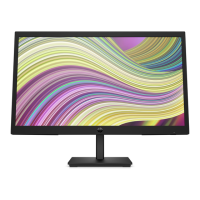
Do you have a question about the HP P22v G5 and is the answer not in the manual?
| Color depth | 8 bit |
|---|---|
| Color gamut | 72 % |
| Pixel pitch | 0.25 x 0.24 mm |
| Screen shape | Flat |
| Pixel density | 103 ppi |
| Display diagonal | 21.45 \ |
| Surface hardness | 3H |
| Native aspect ratio | 16:9 |
| Vertical scan range | 48 - 75 Hz |
| Maximum refresh rate | 75 Hz |
| Horizontal scan range | 54 - 88.1 kHz |
| Contrast ratio (dynamic) | 8000000:1 |
| Contrast ratio (typical) | 3000:1 |
| Display number of colors | 16.7 million colors |
| Display diagonal (metric) | 54.5 cm |
| Display brightness (typical) | 200 cd/m² |
| Supported graphics resolutions | 640 x 480 (VGA), 720 x 400, 800 x 600 (SVGA), 1024 x 768 (XGA), 1280 x 720 (HD 720), 1280 x 800 (WXGA), 1440 x 900 (WXGA+), 1600 x 900, 1680 x 1050 (WSXGA+), 1920 x 1080 (HD 1080) |
| HDCP | Yes |
| HDMI version | 1.4 |
| AC input voltage | 100 - 240 V |
| AC input frequency | 50 - 60 Hz |
| Power consumption (max) | 21 W |
| Power consumption (standby) | 0.5 W |
| Power consumption (typical) | 11 W |
| Operating temperature (T-T) | 5 - 35 °C |
| Operating relative humidity (H-H) | 20 - 80 % |
| Tilt angle range | -5 - 23 ° |
| Panel mounting interface | 100 x 100 mm |
| Feet color | Black |
| Market positioning | Business |
| Package weight | 4300 g |
| Depth (with stand) | 180.5 mm |
|---|---|
| Width (with stand) | 504.2 mm |
| Height (with stand) | 386.9 mm |
| Weight (with stand) | 2800 g |
| Depth (without stand) | 50.8 mm |
| Height (without stand) | 303 mm |
Carefully read the cautions and notes within this document to minimize the risk of personal injury to service personnel.
Repair must be performed by professional service technicians in a repair center. End users should not perform these procedures.
The RoHS (Restriction of Hazardous Substance in Electrical and Electronic Equipment Directive) is a legal requirement by the EU.
This manual contains general information. There are two levels of service: cosmetic/appearance/alignment and circuit board/standard parts replacement.
Firmware updates for the monitor are available at support.hp.com. If no firmware is posted, the monitor does not need a firmware update.
Perform an AC leakage current check on exposed metallic parts to be sure the product is safe to operate without the potential of electrical shock.
Details the monitor's specifications, including screen size, resolution, panel type, and viewing angles.
Identifies and describes the components located on the front of the monitor, such as the power button and LED.
Identifies and describes the components located on the rear of the monitor, including ports and connectors.
Provides instructions on how to find the serial number and product number on the monitor's labels.
Details how to order replacement parts, including HP spare part numbers and distributor information.
Steps to prepare for monitor disassembly, including safety information and required tools and materials.
Procedure for removing the rear cover, including steps for unscrewing and disconnecting components.
Procedure for removing and replacing the power board, including important safety precautions and repair conditions.
Instructions for repairing connectors on the main board, identifying the HDMI connector (J3).
Detailed steps for repairing the HDMI connector J3, including desoldering, component replacement, and soldering.
Procedure for cutting and applying a gasket to the shielding for the HDMI connector to prevent short circuits.
Confirms that all functions are working correctly after repair, focusing on HDMI display and sound output.
Provides solutions for common problems, listing potential causes and recommended actions for screen and input issues.